“Parking should be friendly, but not free” — Dr. Donald Shoup
In October 2019, Green Action Centre partnered with the Downtown Winnipeg BIZ to bring Dr. Donald Shoup to Winnipeg for Parking And The City. This two-day event had the goal of bringing planners, developers, parking managers, city councilors, stakeholders and citizens together to hear from one of the world’s leading experts in parking. Those in attendance had the opportunity to learn, debate and envision how changes to our management of parking could transform our cities.
PARKING AND THE CITY: Trolley Tour
Day One: Wednesday, October 9th
Key stakeholders gathered in the boardroom of Artspace for a short, summary presentation from Dr. Shoup on his three main recommendations: charge the right price for on-street parking, eliminate parking minimums, and put the money raised from parking towards improvements on the metered streets.
The group then boarded the Winnipeg Trolley for a two-hour tour through the Exchange District, The Forks, St. Boniface, Waverly West, Kenaston, Corydon and Downtown. On the tour, each delegate had the opportunity to ask Dr. Shoup a question.
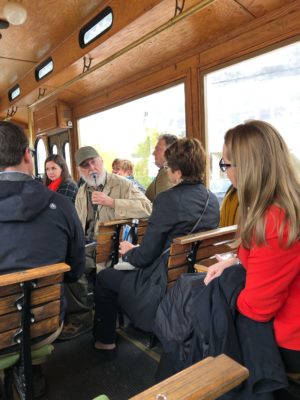 Key Highlights:
Key Highlights:
Exchange District:
- Dr. Shoup noted, as we began our tour through the Exchange, that many streets had no cars parked, while other streets had one to two spaces available.
- Recommendation: the price is too high on the empty streets, and the city should lower the price in the morning hours. Or, perhaps, only begin to charge for parking on those streets in the afternoon.
- John Giavedoni, a resident in the Exchange, noted how he watches cars circling almost every night when events are on. He sees the same cars circling the block on a quest for a free parking space. Dr. Shoup highlighted that in Winnipeg, free parking begins at 5:30 PM, which encourages citizens to go out to hunt for a parking space at 5 PM, during the height of rush-hour traffic. Often, employees of businesses in the area fill the free parking spaces at this peak time. And of course, if spaces are free in the evening, it should be expected that those going out for the evening would search for the free parking space.
- Recommendation: charge for parking until a later time to avoid adding to rush hour traffic and to reduce demand for on-street parking.
The Forks:
- Rachelle Tiu spoke about how The Forks moved in stages from having ample free parking, to charging for parking in all lots in 2019. The Forks has clear signage at each pay station articulating that parking revenue is being invested in improvements to the site (similar to a Parking Benefit District). While some visitors expressed frustration with now having to pay for parking, their visitor numbers overall have not gone down, and have in fact risen. They are also investing in improved infrastructure for biking to their site. They want to encourage visitors to consider options beyond the car.
Downtown:
- Cllr Browaty asked questions around dynamic, or surge, pricing. He noted that downtown, on nights where there are big concerts or Jets games, the city should consider not just charging for on street parking, but raising the price to meet the demand.
- Recommendation: Dr. Shoup noted that private parking lots already do this, and the city would be wise to price their parking according to market demands.
- Donna Olson, of the Winnipeg Parking Authority, noted the hurdle they are facing in dynamic pricing, is that the current meters do not support this technology. Currently, any time a change to the rates occur, they must bring in a technician to adjust the meters, which is cost-prohibitive.
- Recommendation: Dr. Shoup noted many cities have moved completely to a web/app based payment system. This reduces the hard technology costs. To prepare citizens for the move, Dr. Shoup recommended offering discounts currently to parkers who pay via the app. This will encourage folks to try the new technology and prepare for future change.
Waverly West:
- Cllr Lukes noted the condos in Waverly West charge monthly for parking spaces (they are not bundled with the cost of the unit). The issue this has created is that residents will pay for the parking spot during the winter, but during the summer they choose to park on the surrounding residential streets. This creates conflict with homeowners on those streets, who then don’t have on street parking for visitors.
- Recommendation: Dr. Shoup noted that “any neighbourhood without a permit process doesn’t have a parking problem.” If those parking in the neighbourhood had to have a permit, it would discourage folks from parking “for free” during warm months, as their cost for parking at their condo would then go towards purchasing a permit. Donna Olson, WPA representative, was able to speak to this in more detail, and how they can indeed make this work for suburban neighbourhoods. We hope to hear from Cllr. Lukes in the future should a permit program be implemented!
Other Highlights:
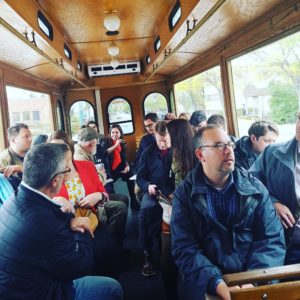 In an online payment system, the city can give discounts for smaller vehicles, electric vehicles, neighbourhood residents etc. The city can encourage citizens to move to more sustainable modes by offering discounts (as opposed to charging more, which leads to the belief that parking is a “cash grab”.)
In an online payment system, the city can give discounts for smaller vehicles, electric vehicles, neighbourhood residents etc. The city can encourage citizens to move to more sustainable modes by offering discounts (as opposed to charging more, which leads to the belief that parking is a “cash grab”.) - Studies of Winnipeg streets showed the city could be making $67,200 per week on streets where parking is currently free. By putting even half of this money back into those neighbourhoods, incredible improvements could be made to lighting, sidewalks, bus stops, bike infrastructure and more. If each neighbourhood could decide how they would like to spend the revenue, citizens are more likely to be on board with changes.
- Winnipeg has many surface parking lots that have been “grandfathered in” and the city has limited ways to work with the owners to inspire development. In Montreal, for example, they began charging $8,000 per year per space on its surface parking lots, which resulted in most of those lots being developed. Overcoming this hurdle is key to truly revitalize our downtown.
Thank you to Dr. Shoup, the Winnipeg Trolley company and our participants: Cllr Janice Lukes, Cllr Jeff Browaty, Donna Olson (WPA), Bjorn Radstrom (Winnipeg Transit), Elise Finnegan (Wpg Planning, Property and Development), Rob Kstiuk (Wpg Planning, Property & Development), Michael Robinson (Wpg Planning, Property and Development), David Patman (Public Works), Chris Baker (Public Works), Colin Fast (Winnipeg Chamber of Commerce), Rachelle Tiu (The Forks), Philip Mikulec (Peg City Car Co-op), Kate Fenske (Downtown Winnipeg BIZ), Melanie Andrushko (Downtown Winnipeg BIZ), Tracey Umali (Downtown Winnipeg BIZ), David Pensato (Exchange District BIZ), John Giavedoni (Residents of the Exchange District).
PARKING AND THE CITY: Rethinking Parking to Transform Our Cities
Day 2: Thursday, October 10th
We welcomed over 130 guests to the Winnipeg Convention Centre for Parking And The City, Dr. Shoup’s keynote presentation. We extend our thanks to Peg City Car Co-op and the Winnipeg Chamber of Commerce for their sponsorship to help make this event happen.
We have Dr. Shoup’s full presentation recorded here. You can follow the presentation with Dr. Shoup’s slides, accessible here.
Key Highlights:
Parking Requirements:
- Parking requirements may look scientific, but they are mere mysticism. They are “very dangerous nonsense” that cities should do away with. This doesn’t mean no parking will be built, it simply means the developer will decide how many parking spaces are necessary.
- City planners are not taught how to calculate parking requirements, they are simply in charge of enforcing parking requirements. Parking requirements are often copies of parking requirements in other cities.
- When it comes to parking, we have politicized what should be a business decision.
- Dr. Shoup pointed out how surprised he was by the amount of surface parking in downtown Winnipeg, and what a shame it was to see this blight.
- Parking lots create no jobs and pay almost no taxes. We need to think about what could go on these spaces, such as; housing, parks, etc.
Parking Benefit Districts:
- Parking Benefit Districts can offer many benefits for those in the neighbourhood that generate it. Cities have offered: free transit passes to those that work in the metered district (Colorado), free wifi, removing graffiti, steam cleaning sidewalks monthly, sweeping every night, better lighting, landscaping etc.
- Old Pasedina went through a dramatic revitalization when a parking benefit district was created. They generated $80,000 per block each year. Initially, business was opposed to paid parking, but when the city offered to return all of the revenue to the neighbourhood, businesses were on board.
Demand-Based Pricing:
- Properly priced parking is the “Goldilocks Principle”: Not too high, not too low.
- Charging the right price is better for business: parking spaces are well used, but one or two spaces are readily available near your shop.
- We watched a promotional video for changes SF Parking has implemented, based on Dr. Shoup’s research. Check it out here.
- It is important to note that, overall, the cost for parking went down through SF Parking reforms. It was not a cash grab.
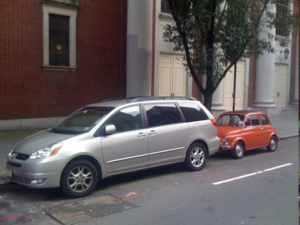
Should these vehicles pay the same amount to park?
- Enforcement for parking violations should be directed towards getting compliance, not profit. First offence gets a warning, second a small fine, a third offence, a larger fine etc. This reiterates that enforcement is not a cash grab.
- Vehicles cruising for parking can be a significant percentage of traffic (up to 70% during peak times), and these drivers can behave erratically in their quest to get a curb parking space.
- It’s important for cities to examine what the best use of curb space is. By reducing curb parking, cities find more space for: bus stops, loading, bike lanes, bike parking, patios, parks etc.
- How to make meter parking popular: give discounts for city residents, discounts for cleaner cars and discounts for shorter cars.
Summary:
- No matter your political affiliation, whether you’re a business owner or a customer, a developer or a renter, you have much to gain by your city solving its parking problems.
All of us, if we are reasonably comfortable, healthy and safe, owe immense debts to the past. There is no way, of course, to repay the past. We can only repay those debts by making gifts to the future.” — Jane Jacobs
PARKING AND THE CITY: Breakout Sessions
“During the group discussions with a private sector planning consultant, I learned a bit more about parking management plans, whereby developers can submit to the City proposals for variances on the parking requirements for a given land use. Looking at the success of sites where these plans are in place could be a valuable tool in re-examining the existing off-street parking minimum standards.” — Participant feedback
Following Dr. Shoup’s presentation, guests were able to take part in two of three discussion groups. Each group was given a problem to solve or an issue to discuss, allowing participants to get to know each other better and to more closely analyze Dr. Shoup’s recommendations within the local context. Below are some notes taken from each group.
Parking Benefit Districts: How Neighbourhoods Can Gain from Parking
Question: What could our cities gain from this revenue model? What would need to be considered to make it a success?
Discussion: The groups determined that parking benefit districts would be suitable for a number of streets and areas in Winnipeg, as long as businesses, customers, and residents were considered and consulted. When exploring the Corydon Avenue example, groups determined specific boundaries (Mulvey to Grosvenor, Nassau to Wilton) in which the revenues would be distributed, to keep in mind the parking that would be displaced onto residential streets. To account for this, the concept of ‘residential parking permits’ was discussed, to ensure parking was being paid for (to some degree) on every street within the boundaries. When determining how the money would be spent, it was presented that the BIZ, resident associations, and councillors could set those enhancement projects. Some possible projects included; accessibility improvements, street flowers, lights, programming, improved bus stops, cycle lanes, greenways, and additional maintenance. It was determined that this should be implemented as a pilot for approximately 3-years, beginning with Corydon and expanding to Osborne Village, West Broadway, Provencher, Transcona, Academy, and more.
Parking Minimums vs Parking Maximums
Question: What are the fundamental differences between parking minimums and maximums? How can our cities change these requirements and what adaptations are necessary?
 Discussion: The groups were in agreement that parking lots are commonly designed for maximum capacities, such as; a mall parking lot being designed to fit capacity for holiday and Black Friday shopping crowds. Instead, it was proposed that lots be built to satisfy the minimum capacity while investing in other modes of transportation. Many groups put forth the idea that malls have the potential to be transit hubs, with this rarely being capitalized on. Malls could reduce the demand for parking by providing safe bicycle parking, improved pedestrian walkability, additional green space, and development of a transit terminal. The group focused on a residential development determined that there should be no parking minimums, allowing the market and developers to decide the amount needed for that unique location. Parking minimums make it virtually impossible to build housing for low-income folks in areas within a walkable/busable distance to daily needs. Another key takeaway was that we need incentives in place for design to be done differently, by providing incentives to build dense, infill housing/commercial developments, we can get the greatest tax value of the available land.
Discussion: The groups were in agreement that parking lots are commonly designed for maximum capacities, such as; a mall parking lot being designed to fit capacity for holiday and Black Friday shopping crowds. Instead, it was proposed that lots be built to satisfy the minimum capacity while investing in other modes of transportation. Many groups put forth the idea that malls have the potential to be transit hubs, with this rarely being capitalized on. Malls could reduce the demand for parking by providing safe bicycle parking, improved pedestrian walkability, additional green space, and development of a transit terminal. The group focused on a residential development determined that there should be no parking minimums, allowing the market and developers to decide the amount needed for that unique location. Parking minimums make it virtually impossible to build housing for low-income folks in areas within a walkable/busable distance to daily needs. Another key takeaway was that we need incentives in place for design to be done differently, by providing incentives to build dense, infill housing/commercial developments, we can get the greatest tax value of the available land.
Circling The Block: How Getting The Price Right Will Impact Traffic
Question: How can market-based pricing improve traffic, increase safety, and lower the stress level of drivers? What needs to be adjusted for Winnipeg to adopt this parking pricing model?
Discussion: In Winnipeg, the current technology does not accommodate this type of demand-based pricing, and it would require significant capital investment by the city to make this possible. The groups compared different rate ranges between on-street and parkades, with which these price disparities are brought to light when there is increased demand for parking. Groups agreed that providing certain discounts, based on residence, vehicle size, and fuel-efficiency are essential in driver’s willingness to pay based on market demand. Although the market is able to determine the pricing, it is important to consider the threshold of what a community can afford and adjust accordingly. It was then proposed that a pilot program be developed in the theatre district with benefits and discounts being made available for persons with lower income and/or reduced mobility.
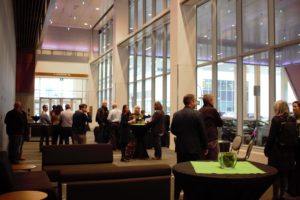
Following the breakout sessions, participants enjoyed complimentary beverages and the opportunity to mix and mingle, while watching those attending the nearby Home Opener for the Winnipeg Jets scramble to secure the curb parking spaces at 5 PM.
GO JETS GO!
Thank you to everyone who attended Parking And The City, we had representatives from:
Cllr, Janice Lukes, Cllr Jeffrey Browaty, Cllr Ross Eadie, Cllr Vivian Santos, AECOM Canada Ltd, Anderson Co, BDC, BentallGreenOak, Bike Winnipeg, Cambrian Credit Union, Canadian Footwear Ltd, City of Brandon, City of Winnipeg Dillon Consulting Ltd, Downtown Winnipeg BIZ, Exchange District BIZ, Green Action Centre, HTFC Planning & Design, Impark, Infotechnika, Longboat, Longboat (Indigo), Manitoba Infrastructure, Manitoba Restaurant and Food Service Association, MORR Transportation Consulting Ltd, Nadi Design, Nepture Properties Inc, Peg City Car Co-op, PlaceMakers LLC, RBC Convention Centre, Remax Professionals, Stantec, Technology@work.ca, The Forks Renewal Corporation, University of Manitoba Parking, University of Manitoba Sustainability Office, University of Winnipeg, Urban Systems, Brandon Downtown Development, City of Kenora, City of Winkler, Town of Niverville, West Broadway BIZ, Winnipeg Airports Authority Inc, Winnipeg Chamber of Commerce, Winnipeg Parking Authority, Winnipeg Regional Health Authority, Winnipeg Transit, WSP Canada Group Limited, YIMBY (Yes In My Backyard) Winnipeg.
Please take a moment to review the following support documents from Dr. Shoup, as well as news articles about the event and a summary blog from Elmwood Guy on his blog, Dear Winnipeg.
Media Coverage of the event:
WFP – Author hopes to reform how cities think about parking
CityNews – Local stakeholders look at maximizing parking downtown
Parking Reform Will Save The City – CityLab
The hidden cost of free parking – VOX Videos
Columbus Parking Benefit District – sample provided by Dr. Shoup
Author hopes to reform how cities think about parking – Winnipeg Free Press
Jurassic Park(ing) Policies – Dear Winnipeg Blog
Photos by Leif Norman.
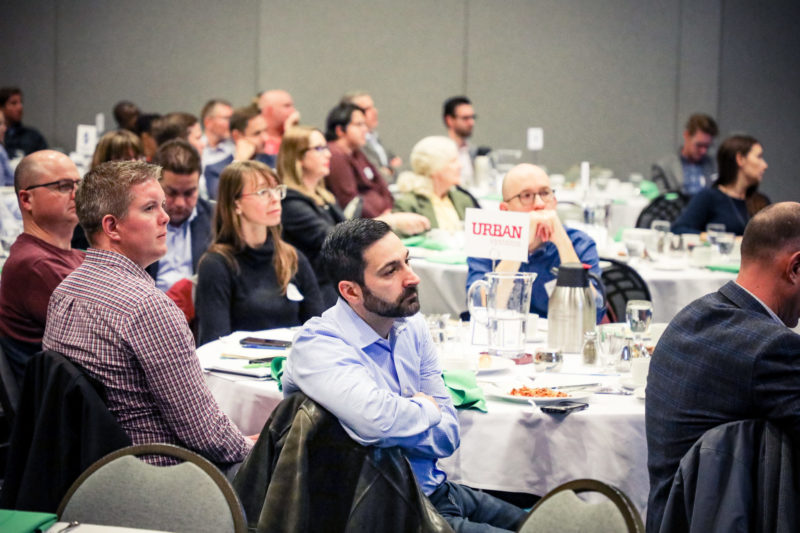



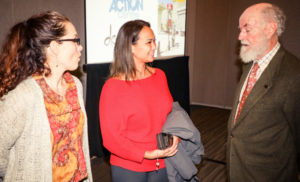
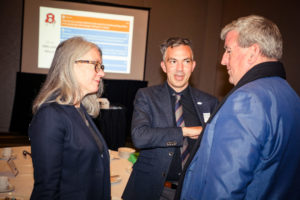


Consideration must be made for people who are credit card free. My husband and I have no credit cards so we do not use the meters . We do not park downtown. In the last few years that we did park downtown resulted in tickets and we just don’t want the hassle. Also going to pay a ticket on portage is a very very inconvenient location. Sure paying on line is fine but if you need to go there it’s absolutely ridiculous location. You should send out surveys to residents asking what are our issues and what isn’t working and what is working, young people and older people have different issues. I’m sure you’ll get a good response on and a few surprising insights on frustrations residents might be having. Also biking to a mall is ok if meeting someone for coffee but if I’m buying larger multiple items it’s not doable. It’s not just parking but why parking. Thank you for this initiative, I’m sure many good things will come out of it and a cleaner safer city is very important.
Great comment and thanks for reading! Yes, one thing Dr. Shoup highlighted is the importance of consultation. It’s very important to hear from the community and respond. Communities who have done that right have seen fantastic results! In terms of how to ensure folks who don’t have access to smartphones and/or credit cards, cities have found solutions and it’s all a matter of learning about all of the options out there, and navigating our way through. I agree that many great things can come out of moving to transform our cities by rethinking our parking programs!
I do own a smartphone. I am on a pay-as-you-go plan and wherever possible I use my home wifi or other free wifi areas. I turn off my data and only use if absolutely necessary. I do not and will never use my smartphone to pay for anything including parking. My 85 yr old aunt does not have a smartphone. Nor is she able to walk any distance to find a parking meter. Having recently been to a business on a very busy street (Logan Av in early afternoon), I was dismayed to find NO parking meter on the block I was at. There was one in the middle of the next block and another in the middle of the next block in the other direction. There was one, however across from me on the very busy street. It took me 4 minutes to get across the street to get a ticket and then more than 5 minutes to get back across the street! What if my aunt had come here on her own and even worse, what if it was winter with snowbanks. What if she managed to get across the street only to find it only had an online payment system! Please, will the powers that be not take away a person’s ability to pay for parking without an online option? There are more of us out there than you realize. And do not remove anymore machines. It’s hard enough to get to the few that are left now.
Hi Mrs. Price – thanks for reading and taking the time to respond. One thing Dr. Shoup repeatedly highlighted was how essential consultation was. It’s important to ensure folks with and without access to credit cards and technology can live freely. I would say that one of the main benefits of implementing these changes is that it opens up funding and space to dramatically improve public and healthy transportation. It would be even better if your 85 year old aunt didn’t have to depend on having a personal vehicle to access her community, or losing access when she is no longer able to have a license. A future where your aunt had frequent, convenient and comfortable transit from her neighbourhood across the city would be ideal – no need to worry about parking, snowbanks or shoveling at all. A dream!
You make parking more difficult or expensive I just won’t go downtown anymore period. That is a fact .
Hi Bob – thanks for reaching out! If you read through the summary and watch the presentation, you’ll see that the cost of parking often decreases when cities follow Dr. Shoup’s advice (for example, we have the link to SF Parking, which resulted in a lower overall cost than before the updates were made). While some streets are always full and an increased price manages the demand, other streets see their parking rates reduced, sometimes to just 25 cents an hour, or free until, say, noon. Municipalities who have incorporated Dr. Shoup’s recommendations have had positive responses from business, residents, and governments. We truly have much to gain by beginning to implement these findings.
Re PARKING AND THE CITY: Trolley Tour
Thank you for this comprehensive report.
I’m concerned by the suggestion to make all paid parking app-based. This assumes all drivers own a smart phone and have a data package. Not everyone can afford a smart phone — and some who can afford it simply chose not to in order to reduce the distractions and demands of technology.
Are there any suggestions for how these people can be accommodated?
Great comment! From what we’ve seen, cities moving to an online payment system can still have a few kiosks for those who don’t have or want to use a cell phone. Previously, we had parking meters for every two spots, then we moved to one pay machine per block. New methods allow for machines to be placed strategically where needed, reducing hard technology costs to the city. The bonus of this technology is, should you want to extend your time, you can use any kiosk near you, you don’t have to run back to the machine nearest your vehicle.